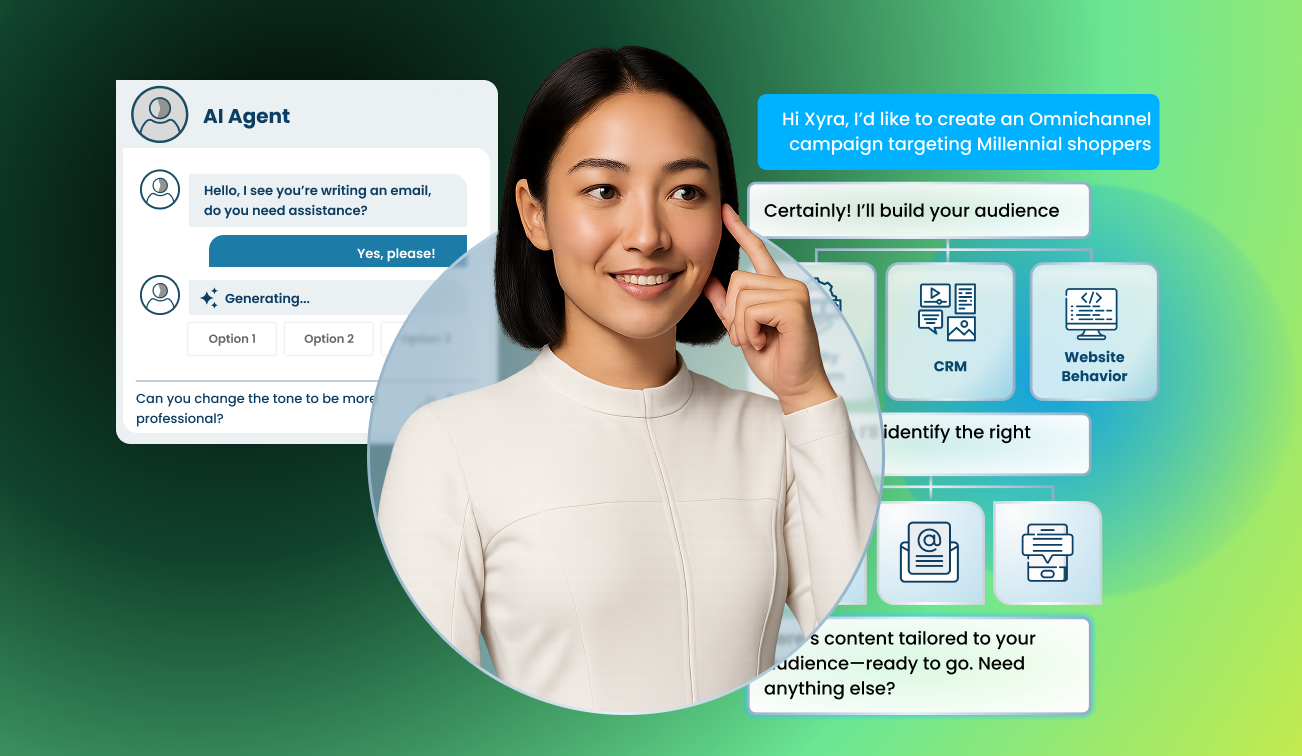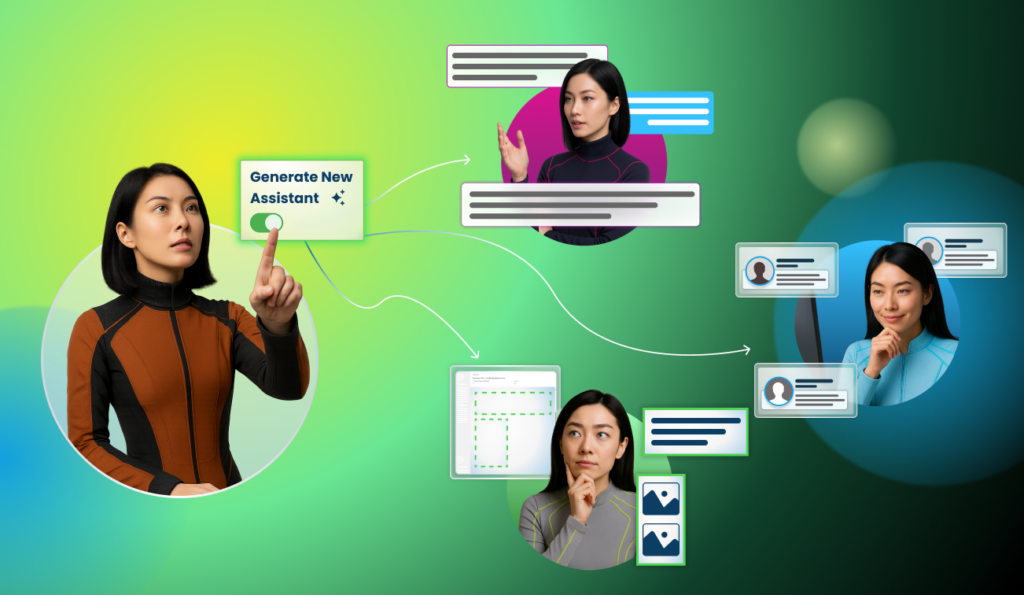What it Means To Be The World’s first AI-native Omnichannel Platform

There is a lot of confusion out there when it comes to the difference between AI agents and agentic AI. This is an important distinction because Experiture is doing a lot more than our competitors, who are essentially dropping AI agents on top of an existing SaaS UI. This is a step forward, but it’s not enough.
What we are doing is transformative: building the industry’s first AI-native omnichannel platform by completely rearchitecting from the ground up to create an agentic experience for marketers. We are building AI-first software that engages with people the same way they engage with other humans.
Our vision:
- Reimagine SaaS for advertising and marketing with an AI-first approach
- Change the way marketers use technology through agentic AI
- Connect the disparate worlds of advertising and marketing
AI Agents Versus Agentic AI
An AI agent can be defined as a standalone software entity that uses an AI model to complete one defined task with some autonomy. AI agents are typically bots, plug-ins, or micro-services (e.g., a help-desk triage bot), and their scope tends to be narrow in that they execute a prescribed action and stop.
Agentic AI, by contrast, is essentially a system of cooperating agents that can plan, reason, delegate and iterate toward higher-order, complex goals with limited human oversight. Agentic AI can be viewed as an orchestrated multi-agent “assembly line” (e.g., prospect → quote → contract → invoice across four SaaS apps), and its remit is broad, for example, it may decide what to do next, spin up new agents, hit different service APIs, and reroute when conditions change.
AI & SaaS
When it comes to SaaS applications, AI agents are typically best suited to handle straightforward tasks, for example a “Reply” button in an email app that calls an LLM to draft text. AI agents typically pull from a limited data set to read only the information required (e.g., one support ticket) to complete the defined task. And AI agents typically sit on top of a SaaS UI acting as an add-on feature to an existing module or capability.
Agentic AI forces us to rethink SaaS in the way we have known it for the past two decades. You can think of Agentic AI as a chat-based interaction layer that enables users to instruct a system to engage in complex tasks, for example “Schedule a QBR with client A, attach last quarter’s usage deck, and alert my team.” Given this example, the agentic AI “orchestrator” would then book a meeting in Teams, pull usage stats from Snowflake, assemble a deck in PowerPoint, and ping the team on Slack—no manual interventions needed.
Because they manage complex tasks across multiple agents and systems, Agentic AI solutions must maintain a shared memory store so every sub-agent has access to the latest customer context and can update as more is learned. The agentic AI layer essentially acts as an OS layer that accesses multiple SaaS APIs along the workflow to achieve its task.
For SaaS applications, the distinction between AI agents and agentic AI is very important for a couple reasons:
- User Experience: AI agents are built on top of an existing SaaS UI and offer feature-level boosts (“Click once, get draft”), while agentic AI promises true outcome-level interactions (“Tell me the goal, I’ll get it done”).
- Vendor Economics: AI agents add value by making the existing SaaS user experience better, but typically keeps customers within the same license tier regarding both features/modules and number of seats or users. Agentic AI, on the other hand, is potentially disruptive to existing SaaS business models because it offers the promise of outcome-level interactions (“Tell me the goal, I’ll get it done”) by hitting different APIs and MCP servers.
Bottom line, an AI agent is a smart tool, whereas agentic AI is an autonomous workforce. AI agents are an incremental feature. Agentic AI offers the promise of rewriting the SaaS value chain by shifting control from individual applications to outcome-oriented orchestrators.

Why Experiture’s AI-Native Omnichannel Platform changes the game
1. AI at the core, not the edges
Experiture’s current iteration, Experiture 9.0, was built with three native AI agents called Xyra: Journey AI, Predict AI and Generate AI—so every touch-point is scored, timed and personalized in real time. Xyra ingests live event streams, predicts next-best actions, and even drafts channel-specific creative on the fly, eliminating the “export to another tool” lag that kills relevance.
2. One brain for every channel—digital and physical
Where most stacks stop at email and push, Experiture’s omnichannel AI orchestrates email, SMS, mobile wallet, web, automated direct-mail, PURLs, QR codes, IVR, geofencing, and even paid media activation—all from the same canvas, guaranteeing message consistency and eliminating channel silos.
3. First-party data becomes instantly actionable
Its built-in Customer Data Platform (CDP) unifies CRM, commerce, and behavioral events into a single profile, then pipes those profiles straight into the orchestration layer—no third-party connector fees, no overnight batch windows. Marketers simply drag a “Predictive Audience” node onto the workflow and go.
4. Agentic autonomy means less babysitting
Experiture is designed to empower intelligent action at scale, grounded in first-party signals. The platform doesn’t just recommend; it can launch, pause or re-route campaigns when KPIs drift, freeing teams from dashboard micromanagement.
5. Built-in paid-media activation closes the loop
A new paid-media activation layer pushes high-propensity audiences directly into walled-garden and retail-media networks, letting brands run acquisition, nurture and re-engagement from the same data spine instead of juggling a CDP, a DMP, and multiple onboarding vendors.
6. Proven lift at scale
Publishers using Experiture report a 285% average response-rate increase after migrating to its AI-driven journeys—a hard performance delta that CFOs notice.
7. Faster time-to-value for lean teams
A drag-and-drop workflow builder, pre-built vertical templates, and 49+ turnkey CRM integrations mean most clients launch highly personalized omnichannel campaigns in weeks, not quarters. As we roll out additional AI agents and agentic AI tools in the coming months, it is our goal to build a groundbreaking experience in which AI collaborates autonomously with marketers to drive superior outcomes.
8. Future-proof privacy & measurement
Because the entire stack runs on authenticated, consented first-party data—and because Experiture can suppress or swap IDs at the edge—marketers stay addressable after third-party cookies and other signals fade away while gaining deterministic closed-loop attribution across every channel.
Bottom line: Experiture collapses what used to take five separate platforms—CDP, ESP, mobile-push, direct-mail tool, and data-onboarding partner—into a single, AI-driven brain that plans, creates, delivers and optimizes across all channels. That’s why we are going to market as the world’s first “omnichannel AI platform.” The result: more relevant journeys, fewer vendor fees, and growth marketing teams free to focus on strategy instead of stitching systems together, clicking on buttons, or adjusting settings.
Want to learn more?
Let’s chat: [email protected]
Ready to Transform Your Marketing?
Discover the difference Experiture can make for your business. Schedule
a demo today to explore how our AI-powered platform can elevate
customer engagement, drive loyalty, and deliver measurable results.

